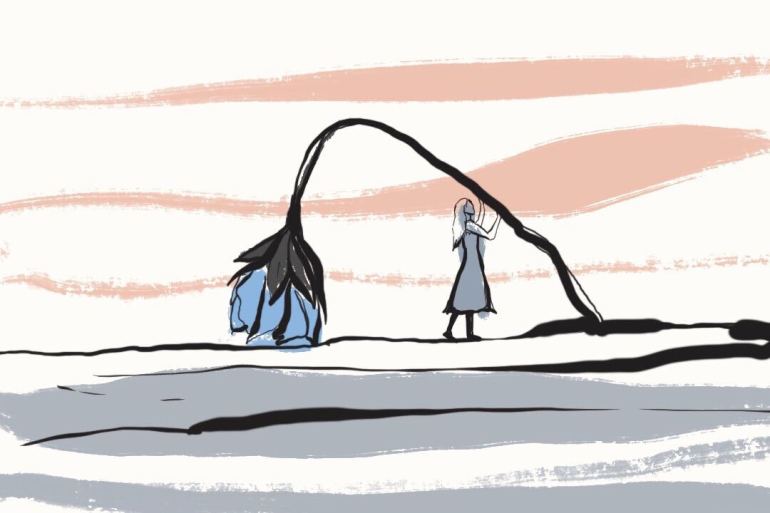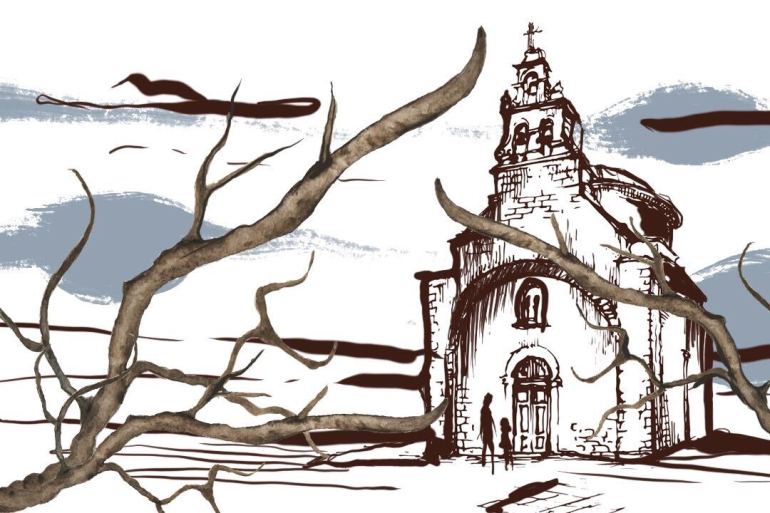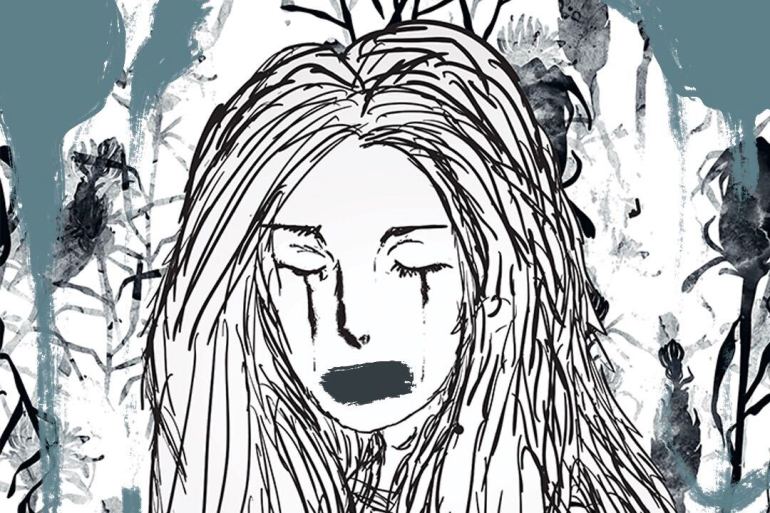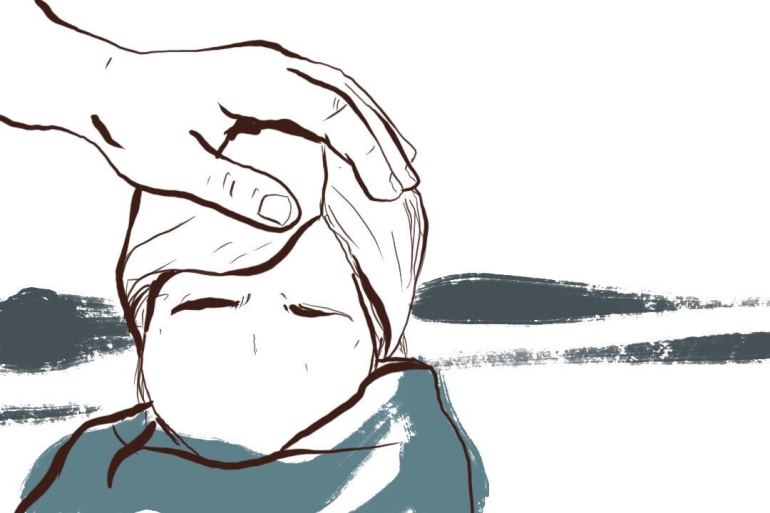‘Trapped’: The American women and girls forced into marriage
Women and girls are still being coerced into abusive marriages, including many under the age of 18. Between 2000 and 2015, more than 200,000 children were married in the US, where some states still allow it.

“A week after we got married, my husband became violent. He flew into rages and controlled every aspect of my life. I couldn’t have my own money, have a driver’s licence, go to school – I was trapped for 15 years.”
Fraidy Reiss, a 45-year-old mother of two daughters who lives in New Jersey, grew up in an insular, ultra-orthodox Jewish community in Brooklyn, New York. When she was just 19, she entered into an arranged marriage with a 22-year-old man who was a stranger to her. Reiss had been introduced to him through a matchmaker. After they were married, they moved to an ultra-orthodox community in New Jersey where they both had family members living.
Keep reading
list of 4 itemsMore than 600 Pakistani girls ‘sold as brides’ to China
From child bride to domestic abuse survivor to refugee
Married at 14: Syria’s refugee child brides
Reiss says that in her community, young women, even though they may be over the age of 18, do not have agency to decide when they want to get married.
As girls get closer to finishing high school – usually the only education they can expect to receive – the process of arranging their marriages begins around 11th or 12th grade.
“Not getting married was very shameful. Single women were mocked and treated terribly. I didn’t really have a right to say no,” she says. “I had seen how unmarried women were treated and was afraid of what would happen if I didn’t get married.”
Many girls are forced into a marriage before they have the full rights of adulthood. It is a horrific form of human rights abuse.
‘I hid money in a box of cereal’
After her husband became violent, Reiss saw first-hand just how trapped young women can be. In her religious community, women had no right to seek a divorce – only a man could grant a divorce. While state laws do not support this, many young women may be too frightened to go through the courts to assert their legal rights for fear of retaliation from their own communities. There was intense pressure to get married – and to stay married – and as time went on, life for Reiss and her children grew more dangerous.
Girls were not supposed to go to college in her insular community, but she secretly applied and began saving up enough money to leave her husband. “I kept money in a box of Whole Grain Total cereal in the back of the pantry – somewhere I knew he would never look,” says Reiss. When she was accepted to Rutgers University, about an hour away from where she was living, her husband tried to stop her from going. She went anyway.
When her husband flew into rages, Reiss says she would lock herself and her two young daughters in the girls’ bedroom, sitting on the floor, huddled together as he threatened them with violence from the other side of the door.
During one of these abusive incidents in December 2006, Reiss recalls thinking, “I am going to get out of here. I don’t have to take this,” and leaving for the whole day with her girls. When she came home hours later, he was gone. Reiss changed the locks and when her husband tried to come back a week later, she knew there was no going back. “I have tasted life without you and it is sweet and you are not moving back into this house,” she remembers telling him.
Leaving an abuser often triggers a serious escalation of violence by abusers who are determined to possess and control their partner.
Reiss was concerned for her daughters and says she did not want them to be exposed to any more of this trauma. When she began the process of leaving him, changing the locks and filing for divorce in the New Jersey courts, her daughters were 7 and 11 years old, but Reiss, like many abuse victims when they try to leave, was subjected to continued stalking, threats and harassment.
Perpetrators often escalate their abuse and violence when victims try to flee and, in many cases, support and protection for victims is very limited. “Leaving an abuser often triggers a serious escalation of violence by abusers who are determined to possess and control their partner,” explains Joan Meier, Professor of Law and Director of the National Family Violence Law Center at George Washington University. “Lethality risks are highest at this time. While some communities have battered women’s shelters, they are often full – and police may not take action before the next attack occurs.”
Reiss says her now ex-husband repeatedly stalked and threatened her. Her community shunned her and her own family disowned her. “I am dead to them,” Reiss says. Her last contact with her family was in 2007 when she spoke to her mother over the phone.

Reiss graduated from Rutgers as the valedictorian of her class in 2007 with a degree in journalism and began working as a reporter for the Asbury Park Press. She has since moved about 90km away from the community she had lived in with her husband. Her divorce was finalised in 2010 and she has a permanent restraining order but she reports that her ex-husband’s legal harassment through the courts has continued for years.
Reiss is now the founder and executive director of Unchained At Last, an organisation dedicated to ending forced and child marriage. She says her organisation, founded in 2011, grew quickly as more women trapped in forced and child marriages reached out. “This is happening in all communities and many girls are forced into a marriage before they have the full rights of adulthood. It is a horrific form of human rights abuse,” Reiss says.
An American problem
The problem of child marriage has existed in America for a long time.
It happened to Sherry Johnson, now 61, when she was just 11 years old. She was forced to marry a 20-year-old deacon from her insular Pentecostal church community in Florida. Johnson says he raped her when she was 10 years old; the rape resulted in a pregnancy. Johnson says her church community, including her mother, covered up the rape – and forced her to marry her rapist.
“My mother put the church above her daughter. I had no protection and no one to look after me,” says Johnson.
While the legal age of marriage is 18 in the vast majority of US states (Nebraska is 19 and Mississippi is 21), many states have exceptions and children can marry with parental consent, because of pregnancy or with judicial approval. These exceptions often put children, particularly those in abusive or unstable homes, at increased risk.
There were many missed moments for an adult to intervene in what happened to her, Johnson says. Her school, doctors and hospital staff at Jackson Memorial Hospital (where Johnson gave birth) all saw a pregnant 10-year-old and did not take action. Child protective services did come to her house once and Johnson says she told them that she had been raped, but they also failed to intercede and protect her.
Johnson recalls how she was first taken to the courthouse in Hillsborough County, Florida, to get married, but the court there would not allow it. Her mother later took her to the Pinellas County courthouse which approved the marriage of an 11-year old child.
“Now I could be legally raped,” Johnson says of her marriage. “I was trapped. I had no one to turn to.” Johnson endured years of sexual and psychological abuse as a result.
Indeed, it was not until 1993 that laws outlawing marital rape were passed in all US states (although some states still have obscure legal loopholes that continue to shield assailants in marital rape cases). Some states had moved earlier – the first was Oregon which changed its law on marital rape in 1977.

Despite Johnson’s very young age, there was pressure from the church community to keep having children and she says she was pregnant almost every year of the marriage. In total, she has six children from the marriage.
When Johnson was 16 she went to an attorney seeking a divorce, but she had no means to pay the legal fees and often children that are deemed old enough by the courts to marry are still not able to legally file for divorce if they are a minor. “You are considered old enough to marry, but not old enough to get out,” Johnson says.
The following year, she went to Legal Aid, an organisation that provides support and legal services to those in need, asking for assistance. They gave her $75, which Johnson gave to the attorney and he fought to get her out of the marriage. After years of trauma, Johnson was finally able to get divorced.
Johnson began to speak out publicly about the abuse, help other victims and fought tirelessly for years to change the marriage laws in Florida. She began working with legislatures in 2013 on different bills to stop child marriage, but these bills failed to pass. She kept fighting and, in 2018, Florida finally changed its law. The law now prohibits anyone under 17 from marrying. Seventeen-year-olds must get parental consent, judicial approval and the person they marry can’t be more than two years older.
Johnson, who is no longer a member of the Pentecostal church community, says she was very careful as a parent and limited who had access to her children to prevent them from being abused or targeted. “I was not going to let my children go through that.”
Girls are at risk worldwide
Child marriage is a global, systemic problem heavily rooted in gender inequality, according to UNICEF. Approximately 12 million girls globally are forced into marriage before the age of 18 each year and nearly 650 million women alive today were married before their 18th birthdays.
“Daughters are frequently seen as burdens or commodities because of pervasive gender inequality,” says the United Nations Population Fund. “In places where the groom’s family pays a bride’s price, parents in difficult economic circumstances may marry off their daughters as a source of income.”
Research shows that child brides have a significantly higher chance of living in poverty; being prohibited from attending school; an increased risk of domestic violence, sexual abuse or assault; health problems; and frequent high-risk pregnancies. Girls under 15 are also five times more likely to die in childbirth.
While this practice disproportionately impacts girls, boys can also be forced into marriage.
Child marriages occur in many different countries, religions and cultures, but can be more prevalent in impoverished, rural, religious and conservative communities. UNICEF reports that rates of child marriage are highest in South Asia, Sub-Saharan Africa, Latin America and the Middle East, but they still occur in many other countries, including the US, Canada, Great Britain, Ireland and Australia.
Daughters are frequently seen as burdens or commodities because of pervasive gender inequality ... Parents in difficult economic circumstances may marry off their daughters as a source of income.
Frontline, the investigative journalism programme for the Public Broadcast System (PBS), reports that between 2000 and 2015 more than 207,000 children under the age of 18 were married in the US: 87 percent were girls who were overwhelmingly married off to adult men. This number is likely even higher since some states have not provided data.
Currently, only four US states (New Jersey, Delaware, Minnesota and Pennsylvania) prohibit marriage below the age of 18 outright. Some states have no minimum age requirement if there is parental or judicial approval and other states have a young minimum age. In North Carolina and Alaska, a 14-year-old can marry with judicial approval. But often, judges hearing these cases are not an adequate safeguard for these children and are not trained in family and children’s issues.
“When judicial approval is needed for a child to be married, one might expect that this is because judges have certain training in trauma and child abuse that might inform their granting of an exception. This is not, however, usually the case,” says Dr Sarah Gundle, a clinical psychologist in New York City, who works extensively with trauma survivors. “While many judges have come to realise that understanding the impact of trauma may lead to better outcomes, there is no systematic, trauma-informed training they must undergo to become a judge. The result is that the courts don’t systematically provide protection for these girls and the consequences for these judicial exceptions to marriage laws can be dire.”
In some states, it is not even a judge but a county clerk who has the authority to approve the licence for a child marriage.
Jeanne L Smoot, former senior counsel for policy and strategy at the Tahirih Justice Center, a national non-profit organisation that provides a broad range of services and advocacy to protect immigrant women and girls fleeing gender-based violence, reported in a piece for the Washington Post that parents having the option to consent to child marriage “ignores how vulnerable children are to force and coercion” and “empowers exploitative or unfit parents with final say-so”.
‘The marriage clerk didn’t even look up from her computer’
A lack of judicial safeguards was exactly what caused Donna Pollard to end up in an abusive child marriage.
Pollard, now a 36-year-old mother, was just 14 when a 29-year-old man began grooming her. Pollard says she grew up in an abusive home in Kentucky and, when she was 13, her father died of cancer. After this, things became even more unstable and the situation with her mother got worse. “My mother seemed more eager to get rid of me after he passed,” Pollard says.
Pollard says she started standing up to her mother when she tried to hit her – and her mother took her to a psychologist where, she says, she was portrayed by her mother as having significant behaviour problems. When Pollard was 14 she was admitted to a behavioural health facility in Indiana. Instead of receiving support, she says she was preyed on by a much older man who worked there. Pollard says he was flirtatious with her, would pass her notes, tell her to meet him in a certain area and tell her she was “so mature”.

“He thought I would be easy to prey on,” Pollard says. She was just 16 and he was 31 when he decided that they should marry, and her mother consented to it. Pollard recalls how no adult intervened on her behalf or questioned this. They were married in Pigeon Forge, Tennessee. The day they went to the courthouse, the county clerk issued the marriage licence without asking Pollard any questions or trying to ensure she was safe. “It was cold and transactional; the clerk didn’t even look up from her computer,” she says.
Tennessee, like Kentucky and Indiana, at that time allowed younger girls to marry with parental consent. In 2018, Tennessee and Kentucky raised the minimum age of marriage to 17. In Kentucky, a 17-year-old with parental consent or judicial approval can marry, and in Tennessee, a 17-year-old can marry with parental consent. Both states prohibit a minor from marrying someone who is four or more years older. Indiana changed its law in 2020, but still permits 16-year-olds to marry with judicial approval.
‘Complete and total entrapment’
After she was married, Pollard found herself trapped with her husband and isolated from her peers. She says her husband quickly became abusive and controlled every aspect of her life.
She wanted to continue going to school, but when she tried to enrol in high school after she moved in with her husband and was now living in a different area, she says she was told by the assistant principal that she could not. Pollard says they didn’t want married girls in their school “who would likely just end up pregnant”. Public schools in the US are prohibited from turning away children who are married or pregnant, but Pollard was young and did not have anyone to turn to for help. “I was already in a traumatised state,” she says. “Who did I have to advocate for me?”
Neighbours heard her husband abusing her and called the police multiple times, but Pollard says that when the police came to their home, her husband would tell them that she was the problem. They listened to him and did not take any action.
At one point, she says, she tried to leave and rent an apartment on her own, but found that no one would rent to her since she was a minor. Another time, she attempted to escape to a domestic violence shelter, but was turned away because she was under 18, the required age for admittance. “I begged my mom to let me come home,” she says. But her mother refused. “I was devastated. It was complete and total entrapment.”
When Pollard was 18, her husband tried to strangle her in front of her six-month-old daughter. She began forming a plan to save enough money to leave and later moved back to Kentucky. She was 20 when her divorce was finalised. Her now ex-husband continued his harassment after she left, but – after years of physical and emotional abuse, isolation and trauma – she tried to rebuild.
“I had to begin to dig deep to find my own worth,” she says. She went on to pass her Graduate Equivalency Degree, then got her college degree and, in 2017, founded Survivors Corner, an organisation which helps victims of abuse and “reframes trauma into purpose”. Pollard also works to change laws that still allow child marriage in the US and advocates for abuse victims.
This is state-sanctioned rape. Many of these girls are too young to consent and now that someone allowed the rapist to marry their victim, they can legally continue to rape them.
As Pollard’s case demonstrates, child brides in America can find themselves in the position of being deemed old enough to marry, but too young to be admitted to a domestic violence shelter (children can be admitted to a shelter if they are coming with a parent). Many shelters will not take young girls fleeing domestic abuse because of antiquated “harbouring-a-runaway” laws and licensing requirements which create significant obstacles for them to leave an abuser.
Certain states (such as New York) do allow unaccompanied minors into domestic abuse shelters and some shelters in states, such as in Maryland, say they would take these younger abuse victims on a case-by-case basis. Pollard reports that in Kentucky her organisation has been told by shelters that if a minor comes to them, they will help them, but shelters having enough space and not being at capacity can be an issue, and far too many states still permit these limitations to providing protective housing.
“It is unimaginable to think of children who were married off and then abused while still children being turned away by the one institution that is intended to be a place of refuge for victims of abuse,” says Meier.
Exceptions to state laws that allow young girls to marry effectively legalise sexual abuse and serve as a way to cover up rape and abuse, like in Johnson’s case, especially when the abuse results in a pregnancy, experts argue.
“This is state-sanctioned rape. Many of these girls are too young to consent and now that someone allowed the rapist to marry their victim, they can legally continue to rape them,” says Dr Gundle.
A shadow pandemic
Child marriages also increase during times of crisis and instability, according to organisations such as UNICEF (PDF). The COVID-19 pandemic has significantly worsened this problem. The United Nations Population Fund reports that an estimated additional 13 million girls across the globe could become child brides due to the public health crisis – and in some places, rising poverty and unemployment due to the pandemic are, therefore, causing child marriages to soar. Furthermore, many of the existing efforts to end child marriages have been set back by the pandemic.
Stay-at-home orders and social distancing, while necessary to slow the spread of COVID-19, have created a global shadow pandemic by isolating vulnerable children and domestic violence victims who have had to quarantine with abusers and have limited access to technology, support services, schools and local organisations that provide direct outreach. This has left those at risk unable to seek help, report abuse or tell a trusted adult, such as a teacher, that they are being forced into a marriage.

School closures, in particular, during the pandemic have contributed to the problem of child marriages.
Dr Faith Mwangi-Powell, CEO of Girls Not Brides, an international organisation committed to stopping child marriages, says, “Education is a key protective factor against child marriage. The longer a girl stays in school, the less likely she is to be married before the age of 18 and have children in her teenage years.
“School closures, which are important to contain the spread of the pandemic, are putting girls at much greater risk of child marriage.”
She adds: “Supporting and protecting girls who are already married is also vital – they should be provided with options for re-entry into schooling, sexual and reproductive health information and services, livelihood skills and opportunities, and providing safe spaces and support networks for them to discuss the challenges they face at home.”
In some countries, it may take time to see the full impact of the COVID-19 pandemic on child marriage rates. Initially, marriages may decline due to courthouses being closed during shutdowns, but with increasing economic stress and unemployment rates remaining high, young girls are at an elevated risk.
“Child marriage rates are not as high in the US as in other places, but they do still occur at alarming rates. It is an insidious ‘solution’ that some families may consider due to declining economic circumstances,” Dr Gundle says.
An opportunity for predators
Dr Gundle adds that people are more vulnerable during the pandemic and there can be increased opportunities for predators to “prey on some parents and promise them that they will provide something better for their child, when they will really just be going into a dangerous situation.”
Children and adolescents who have had to quarantine with abusive parents during the pandemic may also see escaping the home through marriage as their only way out, especially if a second wave necessitates further lockdowns, she adds.
To help prevent child marriage, we need policies and programmes that support girls, particularly the poorest and most marginalised.
In recent years, several US state legislatures have passed laws raising the age of marriage and limiting parental consent exceptions, but some experts report these bills have not gone far enough to protect children and that even raising the age to 17 still allows for adolescents to be coerced into marriage. Legislation that was pending before the pandemic in certain states – such as in Michigan (current law allows those 15 and younger to marry with judicial approval) – that would prohibit marriages under the age of 18 could take a back seat to other legislative measures.
“As courthouses become fully operational again, this legislation will likely not be the main priority,” says Dr Gundle. “Legislation could be backlogged for months and trauma is often prioritised last – it may take longer to recognise the cost of this pandemic on child brides in the US, but those with the least power will be deeply impacted.”
Child marriage legislation could also be hindered as COVID-19 cases rise and additional stay-at-home orders are implemented.
“Globally, we need to ensure that our response to the virus both during the emergency and recovery period places girls at the centre of the response,” says Dr Mwangi-Powell. “To help prevent child marriage, we need policies and programmes that support girls, particularly the poorest and most marginalised, to continue their education during school closures, and to return to school when they reopen.”
*If you or someone you know is being abused or forced into marriage, please contact thehotline.org, ncadv.org and unchainedtalast.org in the US, or plan-uk.org, hotpeachpages.net, api-gbv.org and domesticshelters.org outside of the US.